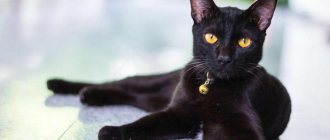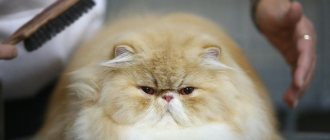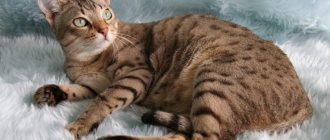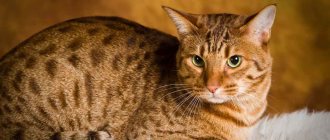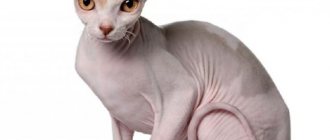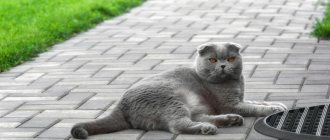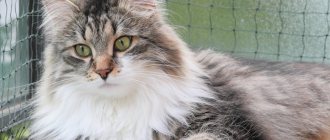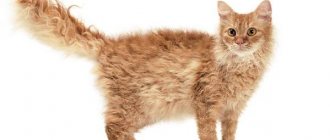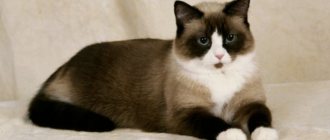Meeting a Chantilly Tiffany , shrouded in lush, deep chocolate-colored fur from crown to tail, with a dark button nose and bright yellow large eyes, can mislead a stranger. The “grimy” pet looks like it recently crawled out of a chimney. In fact, Chantilly Tiffanys are status animals. The truly lucky ones get to meet an unusual, rare cat. The owner of Chantilly is lucky: she is not only a pretty cat, but also balanced, affectionate, and not capricious.
Origin story
The first name for Chantilly Tiffany cats is foreign longhair.
It is unknown how their descendants appeared, but one thing was found out for sure - the descendants of these cats were Asian Longhair and Burmese. In 1967, breeder Jenny Robinson bought a pair of “chocolate” cats: Thomas and Shirley. A couple of years later they had offspring: equally beautiful kittens with bright eyes. Jenny immediately realized that these babies were a real treasure and began breeding the breed. Sinjin Lund, a felinologist who has been studying Burmese cats for many years, helped her with this.
Lund bought all the offspring and brought a couple of individuals to a major New York exhibition. The cats were highly rated, but they didn’t like the name of the breed – “foreign longhair”, and the similarity with the Burmese seemed too close to the experts.
For a long time the matter did not move forward. Kittens were born one by one, but the breed received recognition only in the early 90s of the twentieth century: when other breeders - Jan Deregti and Tracy Oraas from Canada - “added” Somali cats, Nibelungs, Havana Browns and Turkish Angoras to the breed.
The breed received the name “Chantilly Tiffany” to avoid confusion: at that time the Tiffany breed had just appeared in Britain.
Unfortunately, the number of nurseries has decreased over time, not increased: in 2011 there were 6 in North America, in 2003 - 1. In 2011, it burned down. All representatives of the breed died in the fire, with the exception of Frosty the cat. He was transported to a Norwegian nursery, where the last Chantilly Tiffany cat, Acie, was born.
At the moment there are no nurseries, but you can buy such a cat from private breeders.
Cost of kittens
It is not easy to buy such a cat in the Russian Federation - Russian nurseries are not yet breeding this breed. Few people breed them abroad either. The cost of kittens is high because they are rare.
The lowest price that can be asked for a 3-month-old furry baby starts from half a thousand dollars and is determined by a number of features. In addition, you need to take into account the costs of transporting it from the nursery.
Popular kennels for this breed:
- Russia - (your nursery is here);
- Belarus - (take place);
- Ukraine - (submit an application).
Standards
The average weight of males is 4-5, rarely 6 kg. Females weigh 1-1.5 kg less.
| Standard | Description |
| Head | Wedge-shaped, with smoothed features, small. The cheeks are small, the chin is medium size, strong. The forehead is wide and sloping. The whisker pads are round and clearly drawn. The nose is neat, with a small “stop” on the bridge of the nose. The eyebrows (like the mustache) are lush and large. |
| Ears | Large, widely spaced, abundantly pubescent both inside and outside. |
| Eyes | Almond-shaped, the color of the iris is all shades of yellow. |
| Frame | Small, graceful, with well-developed muscles. The limbs are slender, with oval, densely pubescent paws and small, but sharp, claws. |
| Tail | Long, with a sharp tip. Abundantly pubescent. |
| Wool | So thick and long that it gives the animal massiveness and significantly increases its size. The fur is soft, velvety to the touch, does not stick together and practically does not get dirty. Sheds little. |
Significant disadvantages:
- Different color;
- The eyes are green;
- Short hair on the body;
- White medallions;
- Lack of fluffy “pants” and “collar”.
Description of the breed
Chantilly Tiffany is a fairly rare breed, but is gaining increasing popularity among lovers of beautiful semi-long fur of excellent chocolate color. The fur covers the long and slender body, falling in gentle waves, framing the ears and forming an elegant collar, ending with a fluffy tail. The wedge-shaped head has soft outlines and a wide muzzle. Oval eyes are widely spaced, have an amazing color of warm amber, golden sunset, or yellow sun. The ears are small, round and also widely spaced. There are several possible variations in color and color, although initially only chocolate brown was allowed. Today you can find five possible colors: blue, chocolate, synammon, lilac and fawn. Colors can also be different, these are solid, spotted-striped, tabby, and striped mackerel.
Character and behavior
A furry weasel is what breeders kindly call Chantilly Tiffany. This breed is ideal for indoor keeping. Once in your house, the animal will quickly choose one person - its favorite one - and will constantly follow him like a little dog, waking him up in the morning and waiting near the front door after work. And, by the way, under the toilet door too.
It is communication with a person that Chantilly gives preference to. They are soft and reserved, are not afraid of strangers, willingly go to meet guests, but do not allow liberties with themselves. They are easily frightened: if a guest makes a sharp gesture or raises his voice, they quickly retreat to a secluded corner and watch the further development of events from there.
Restraint is another of their distinguishing features, but they also do not shy away from games. Especially if their beloved owner or other pets (with which, by the way, these cats get along very well) will participate.
Chantillies are smart and grasp information on the fly, so they are easy to teach tricks and commands. They look at new objects with interest, and if the owner teaches them through play, then the process will be fun and easy.
They quickly adapt to new places and conditions. But they cannot stand loneliness. This is a real punishment for them! If Chantilly is left alone often and for a long time, she will get sick more often and gradually turn into a real savage.
The cat loves to walk in the fresh air, but letting her go out on her own is very dangerous. A friendly Chantilly Tiffany can be suitable for acquaintance not only with a cat, but also with a dog that can show aggression.
And there are many other dangers lurking for a cat: cars, poisons, and cold. And fleas and ticks brought into the house are unlikely to bring you much joy.
Chantilly Tiffany are more talkers than silent ones. If you prefer quiet, they are not for you.
Chantilly - especially at a young age - are very curious creatures. By trying to stick their nose into all the corners and pots, kids can get an electric shock, burn or other injury, so take precautions in advance: hide all wires away, put special nets on the windows, remove toxic plants, sharp and breakable objects.
Care instructions
Wool
The Chantilly does not have a thick undercoat, so this breed does not require daily brushing. 1-2 times a week is enough. Brush – only a special one: metal, with rounded teeth (or a rubber glove).
Bathing
Clean cats are good at taking care of themselves, but they still need to be bathed from time to time. Not too often (frequent bathing washes off the protective layer and causes skin irritation) - once every 3-4 months and, of course, before the exhibition. But it should be borne in mind that representatives of the Chantilly Tiffany breed categorically do not like to swim: they break out, squeak indignantly and express their dissatisfaction in every possible way. Therefore, it is advisable to enlist the support of an assistant who will hold the animal.
Does your cat like to swim?
Not really
Make sure that water and detergent do not get into your cat's ears or eyes. You can insert cotton swabs into your ears and put a rubber cap on your head. Use only special products for cats (semi-long and long hair). After bathing, gently dry the coat with a towel, but do not rub too hard, otherwise it will become tangled.
Eyes
Inspect your eyes daily; if necessary, wipe off discharge with a cotton swab dipped in chlorhexidine or warm boiled water. It is not recommended to use tea leaves or chamomile infusion: Chantilly wool may take on an unnatural shade.
Ears
The ears are inspected and cleaned weekly using a cotton swab dipped in ear lotion or chlorhexidine.
Teeth
Teeth are brushed once a week using a special toothbrush and toothpaste (Beaphar, Trixie, Cliny).
There are a huge number of cleaning products in veterinary pharmacies and pet stores. Therapeutic, preventive, refreshing, with the taste of mint, fish or meat, with bone meal, specialized tooth powder, special pads...
If your pet meekly allows you to brush its teeth, the problem is easily solved, but what if not? You will have to take him to the veterinarian every year for laser cleaning, and at home you will have to drip gum-cleaning gel into the drinking water.
Expert opinion
Dusheba Vera Ivanovna
In 2010, she graduated from the Moscow State Academy of Veterinary Medicine named after K.I. Scriabin with honors, specializing in veterinary medicine. I regularly attend veterinary conferences, congresses, and webinars.
If your cat's gums turn red and begin to bleed, there is an unpleasant smell from the mouth, hard, yellowish formations appear on the teeth, and there is swelling on the gums - show the animal to the veterinarian.
Claws
Nails are trimmed once a month using nail clippers or a special nail clipper. Be careful to trim the very tip of the nail, being careful not to catch the vessel at the core.
Pictured are kittens of the Chantilly Tiffany breed
Catering
Representatives of this breed tend to gain excess weight, and in a fairly short period of time. Therefore, you must strictly adhere to the recommended proportions and not follow the lead of your pet, who touchingly looks into your eyes and begs for another tasty morsel.
Chantilly Tiffany are amazingly capable actors. If they notice that you reacted positively to their plaintive cries and body movements, they will organize a concert over and over again.
The feeding rules are:
- Adults (over 6 months) should be fed 2 times a day: morning and evening. After eating, bowls should be washed thoroughly (without using chemical detergents). If a cat smells the stench of spoiled food, it will refuse to eat from this dish. Babies are fed 3-6 times a day: the younger the kitten, the more often feedings are carried out. Exceptions also include pregnant and lactating, exhausted and sick animals. Their menu and feeding schedule are discussed with the veterinarian.
- You cannot mix ready-made food and food prepared by yourself. To digest both the first and second, different enzymes are required.
- Clean water at a comfortable temperature (not hot, but not from the refrigerator) should be present in the drinking bowl at all times! Do not feed your cat liquid from the tap: it contains too much chlorine, iron and salts harmful to the animal. A household filter can remove them. You can settle the water (10-12 hours in a dark place, without covering the container with a lid) or buy bottled water.
Natural products
The menu should contain the following products:
- Meat is of good quality and low-fat varieties. These are beef, veal, rabbit, turkey, lamb. The meat is not boiled, much less fried, but pre-frozen in the freezer for a day or two. Before feeding, defrost, pour over boiling water and cut into small pieces. A kitten needs 30 grams per day, an adult cat needs 100-120 grams.
- By-products: liver, stomachs, hearts, kidneys. They can be given raw (except for the liver: it is too heavy for the stomach) or boiled. It is better to grind chicken necks into minced meat.
- Fish: salmon, rainbow trout, cod, chum salmon, halibut, pink salmon, flounder, sardine, tuna. All fins and sharp parts must be cut off from the fish, scales and bones must be removed. You can feed it either raw or boiled (without salt or seasonings). You cannot constantly feed Chantilly Tiffany with fish: the animal’s thyroid function and metabolic processes are disrupted, iron is poorly absorbed, and urolithiasis develops.
- Rice, buckwheat, oatmeal, barley, millet porridge. They are boiled in water; you can add just a little milk for taste. Children cook semolina porridge by adding a drop of honey.
- Fresh or boiled milk is given to kittens up to 3 months. In adult cats, it often causes digestive upset, but if your pet loves it and does not have stomach problems, you can leave the product.
- Boiled chicken yolk (pure or mashed with milk, kefir, yogurt). Give 1-2 times a week.
- Fermented milk products: fermented baked milk, kefir, cream (10%), yogurt, low-fat cottage cheese, natural yogurt, sour cream, unsalted hard cheese. Can be given every day.
- Boiled quail eggs – 3-4 times a week.
- Raw or cooked vegetables: pumpkin, carrots, zucchini, green beans, broccoli, cauliflower, greens (dill, parsley, spinach, lettuce).
- Dry brewer's yeast - 3-4 times a week.
- Vegetable oil: olive, sunflower, flaxseed – half a teaspoon per porridge.
- Vitamins.
To cleanse the stomach of cats, they grow wheat, barley or oats. The animal will nibble on green sprouts at will.
Your cat should always have fresh water, free of chlorine and harmful impurities, at a comfortable temperature. Water can be bought in a store, purified through a regular filter, or left to stand for a day.
It is prohibited to give:
- Pork, duck meat, goose meat, lamb (the body does not digest fatty meat well, in addition, the meat of these birds is often infected with worms);
- Rotten, smelly meat;
- Bones (a cat might choke), tripe, lard;
- Butter;
- Sweets: candies, pastries, cakes, marmalade, marshmallows, marshmallows, sugar, chocolate (chocolate is poison for cats, other foods are poorly digestible and disrupt metabolism);
- Salt, spices, seasonings (not absorbed by the body);
- Human canned food, sausages, sausages, smoked, dried, fried, spicy, fatty foods (disturb metabolism);
- Beans, peas, chickpeas, soybeans, potatoes, tomatoes, eggplants (not digestible, cause stomach upset);
- Vitamins and medicines for people (can cause severe poisoning, even death);
- Dog food (not digestible).
Recommended food
Ready-made foods are convenient and easy to buy (or order online). There are many different lines for animals of all ages, in addition, the presence of chronic diseases and the characteristics of a particular animal are taken into account (for example, for cats with long hair, with a sensitive stomach, etc.).
Cat foods of the economy and premium classes are significantly cheaper than foods of the super-premium and holistic classes, but they also differ greatly in quality.
Firstly, there is practically no pure meat in them (or none at all), and the combination “meat waste” hides food production waste: ground bones, skin and feathers.
Secondly, they are low in vegetables and nutrients, and have an abundance of unnatural preservatives, dyes and flavor enhancers. Of course, your pet will be able to eat, but such food will not benefit its health. Therefore, choose holistic food Orijen, Power of Nature, Wellness CORE and super-premium Leonardo, Naturea, Sanabelle.
Below are recommended super-premium foods. Links with the names of the food are clickable, on them you can, within our website, get acquainted with the descriptions of the food and read reviews from owners of Chantilly Tiffany cats.
| Holistic | Holistic | Super premium |
| One & Only | Savarra | Superpet |
Features of Chantilly content
Before Chantilly Tiffany arrives at your new home, you need to prepare the following items for your pet’s arrival:
- a bed (or, if desired, a house);
- scratching post;
- tray and filler;
- bowls for food and water (not plastic - it is better to choose ceramics or metal);
- several toys;
- necessary products and items for cat grooming and hygiene;
- feed.
You should not buy plastic bowls - they accumulate germs very quickly and absorb unpleasant odors, unlike ceramics and metal
Features of feeding natural food
When feeding naturally, Chantilly-Tiffany should be given the following products:
- lean meat (lean beef, poultry, rabbit or lamb) - about 60% of the diet;
- porridge (oatmeal, buckwheat, rice) - 15%;
- vegetable puree with herbs - 15%;
- cottage cheese and fermented milk products - 5%;
- raw quail eggs - about 2-3 pieces per week;
- lean white sea fish - approx. 70–80 g per week.
The daily feeding regimen is twice, morning and evening, always at the same time. The daily diet should be calculated according to the following scheme: no more than 40 g per 1 kg of cat weight. Water should always be in your cat's bowl, and food only during feeding. Bowls should be washed after each feeding and the water should be changed twice daily. Your cat should always have sprouted oats or cat grass.
Fresh grass contains a lot of vitamins, so your cat should always have it.
Also, with a natural diet, the cat needs to be given vitamin complexes, since it does not receive all the necessary microelements with food. In addition, Chantilly Tiffany must be given malt paste to remove hair from the stomach.
What malt pastes and vitamin complexes are suitable for Chantilly:
- Beaphar Malt-paste - malt paste;
- Trixie Katzen-malt - malt paste;
- Beaphar Irish Cal and Beaphar Top 10 Cat - powdered vitamin supplements;
- Anivital Feliderm - liquid vitamins for skin and coat;
- Excel Brever's East - vitamin tablets with garlic and brewer's yeast.
Before using vitamins, consult your veterinarian - he will prescribe an individual dosage for your cat.
Photo gallery: vitamins and malt pastes for Chantilly-Tiffany
Chantilly Tiffany has long hair, so she needs to be given malt paste regardless of the type of food she eats. Malt pastes are designed to remove hair from the stomach
Top 10 Cat vitamins strengthen all internal organs Irish Cal - a calcium supplement for strong teeth and a healthy skeleton Anivital Feliderm maintains healthy skin and coat Excel vitamins strengthen the immune system and contain many vitamins and microelements
Selection of industrial feed
Cat food must be of the highest quality. Chantilly Tiffanys are quite selective in food, so they will not eat cheap food below the premium class.
The following brands are suitable for feeding Chantilly Tiffany:
- Royal Canin Longhair Indoor (France, premium). The food is designed specifically for long-haired cats living at home. It helps remove hairballs from the stomach and normalizes digestion. Contains substances that are beneficial and necessary for cat fur. All food ingredients are natural.
- Acana Grasslands (Canada, holistic). Very high quality and nutritious food for cats. The difference between holistic foods is that all the ingredients used in them are exclusively natural and were used fresh in production. The food consists of 75% poultry and fish, 20% vegetables, fruits and fiber-rich legumes and chickpeas, 5% greens and medicinal herbs.
- Сarnilove Duck&Pheasant Grain&Potato free (Czech Republic, holistic). Consists of natural ingredients: extracts of medicinal herbs, apples, green peas, as well as pheasant and duck meat. The composition of the food is close to the diet of a cat in the wild.
- Hills Science Diet Hairball Control (Britain, super premium). The food helps remove hairballs from the cat's stomach. It also keeps the animal’s weight normal.
- Eukanuba Indoor Hairball (Netherlands, holistic). The food also removes hair from the cat’s gastrointestinal tract, controls weight and normalizes the functioning of the stomach and intestines. Contains mineral complexes and vitamin supplements.
Photo gallery: food for Chantilly-Tiffany
Carnilove Duck&Pheasant contains pheasant and duck meat Royal Canin Longhair Indoor food is designed for long-haired breeds Acana Grasslands - a nutritious natural holistic food Eukanuba Adult Hairball removes licked hair from the cat's stomach Hill's Hairball Control contains all the substances a cat needs
Wool hygiene
If you expect Chantilly Tiffany wool to have a lot of problems, you are wrong. Despite its impressive length and thickness, it is completely devoid of undercoat. Therefore, it does not get tangled, does not get tangled and does not cause problems in care. But during shedding, which lasts about a month for these cats, the fur falls out very profusely, so daily cleaning cannot be avoided.
Brush Chantilly once every 1-2 days, during shedding - daily in the morning and evening.
What brushes and products will be needed to care for Chantilly Tiffany:
- antistatic spray;
- combined comb;
- furminator for long-haired cats;
The Furminator allows you to remove dead hair from your cat's fur as thoroughly as possible.
- comb with rubber teeth;
- combination brush;
- restorative spray for cat hair.
In what order should you comb your Chantilly Tiffany fur?
- First, an antistatic spray is sprayed onto the wool. It helps soften it and reduce frizz, and also prevents electrification of the coat.
- Then the wool is smoothed with a comb.
- Furminator is used no more than once a week during normal times and no more than once every 4-5 days during shedding. Use carefully, not tearing out, but carefully combing the fur.
- Then you need to comb the fur with a combination brush (the side with the iron teeth).
- After this, the wool is combed out with a rubber brush.
- Smooth out again with a comb and finish combing with the bristle side of a combination brush.
- A restorative spray is sprayed onto the fur. It makes the coat soft and silky, strengthens it.
Chantilly-Tiffany should not be washed too often - usually once every 2 months is enough. But if the cat’s fur quickly becomes dirty, you can increase the frequency of washing to once every 1.5 months.
Wash the cat in a basin in water at a temperature not lower than 39 ° C. The water should reach approximately the middle of the chest. For washing, you should purchase a special caring shampoo.
The following shampoos are suitable for Chantilly-Tiffany:
- Ms. Kiss “Luxurious Lioness”;
- Royal Groom “Volume and Elasticity”;
- BioGroom Protein-Lanolin;
- Trixie Langhaar-shampoo;
- Jerob Herbal Shampoo.
In between washing your cat, you can use dry or spray shampoo. They are applied to the wool and then carefully combed out of it. You can use them every day, but there is no need. It is enough to treat your cat with them once every 5–7 days. They help disinfect the fur and make it cleaner, but do not replace a full wash.
Photo gallery: Chantilly-Tiffany grooming equipment and products
“Luxury Lioness” shampoo is safe for cats Royal Groom “Volume and elasticity” is a professional grooming shampoo Trixie Langhaar designed specifically for long-haired cats Jerob herbal shampoo is produced in Britain BioGroom contains the necessary protein and lanolin for wool
A rubber comb massages the skin and removes dead hair. The combined brush is convenient and practical. The combined comb smoothes the cat's fur.
Care for claws, teeth, eyes, ears
Regular care for Chantilly Tiffany includes:
- Ear cleaning. Produced approximately once every 5–7 days. For this you will need ear cleaning drops, cleaning lotion and a cotton swab:
- First, drops are instilled into the ear according to the dosage.
- Then massage its base for a minute.
- After this, roll up a cotton swab and, moistening it in lotion, place it in the ear to the maximum depth (but without pushing it in).
- The ear is massaged again.
- Take out the swab and wipe the ear with another swab with lotion.
- Eye cleaning. Produced daily. For it you will need lotion to care for the eyes and a piece of natural fabric. The lotion is applied to a cloth and the eye is rubbed with it in the direction from the inner corner to the outer.
- Brushing your teeth. This is done at least once every 2–3 days. For this you need to purchase a cat toothbrush and a special toothpaste. The cat's teeth are cleaned thoroughly, but without force.
- Nail trimming. It requires a special nail cutter - not ordinary scissors. The claws are cut slightly at an angle, maintaining their natural shape and retreating a few millimeters from the sensitive body (the pink, opaque part) of the claw.
A cat's claws are very sensitive, so be careful not to injure them when trimming them.
Diseases
All the advantages of Chantilly Tiffany cats include their good health. To date, no hereditary diseases have been identified. But these animals also have some peculiarities.
- Firstly, the breeders directly indicate that the digestion of Chantilly Tiffany is very sensitive. A menu rich in grains does not suit them. They also have a negative attitude towards frequent changes of diets and feeds.
- Secondly, half of Chantilly Tiffany suffers from tartar and related oral diseases. Therefore, pay special attention to caring for your cat’s teeth and gums.
Deworming once a quarter is mandatory, as are annual vaccinations.
About the health of Chantilly Tiffany cats
Cats of this breed are famous for their excellent health, and proper and timely care can prolong the life of a pet up to 18 years, which is very rare and a real record.
Chantilly Tiffany does not have any hereditary or genetic diseases. The only serious problem that can harm their health is stressful situations.
Fortunately, the constant presence of your beloved owner nearby will not allow this problem to develop and worsen. It is important not to forget about regular visits to the veterinary clinic. This will avoid unpleasant consequences and diseases. It is also important to provide proper care to your beloved pet and carefully monitor its nutrition.
